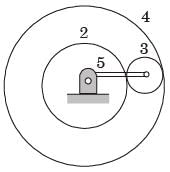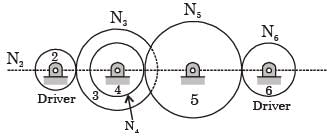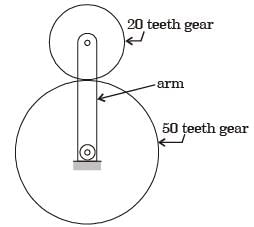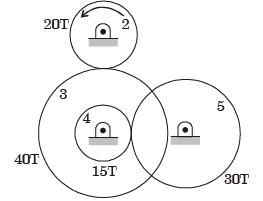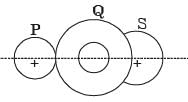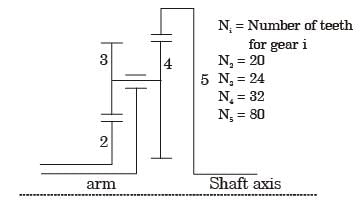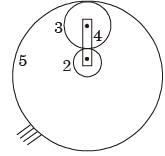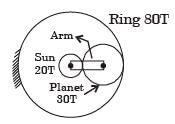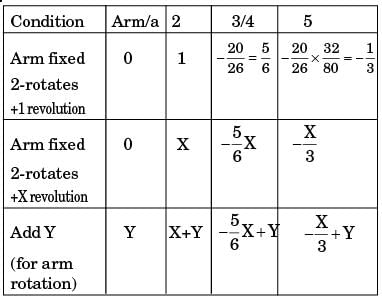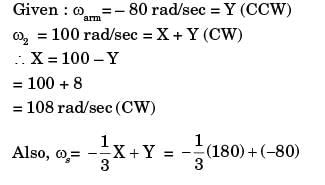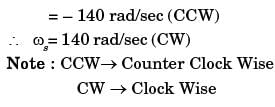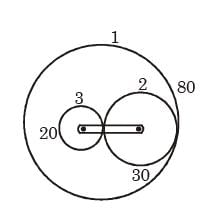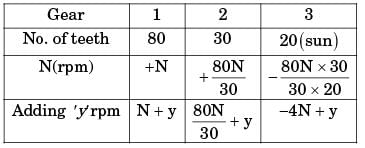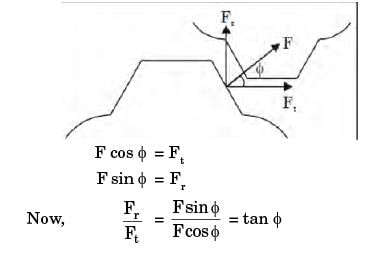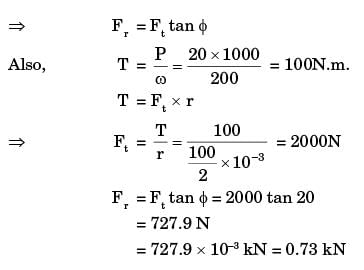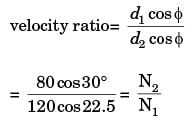Question for GATE Past Year Questions: Gears & Gear Trains
Try yourself:In the gear train shown gear 3 is carried on arm 5, Gear 3 meshes with gear 2 and gear 4. The number of teeth on gear 2, 3 and 4 are 60, 20, and 100, respectively. If gear 2 is fixed and gear 4 rotates with an angular velocity of 100 rpm in the counterclockwise direction, the angular speed of arm 5 (in rpm) is

[2016,Set-1]
Explanation
Given T2 = 60
N2 = 0
T3 = 20
T4 = 100
N2 = 100 rpm (ccw)
Relative velocity equation

1.6Na = 100
Na = 62.5 rpm (ccw)
Report a problem
Question for GATE Past Year Questions: Gears & Gear Trains
Try yourself:A gear train is made up of five spur gears as shown in the figure. Gear 2 is driver and gear 6 is driven member. N2, N3, N4, N5 and N6 represent number of teeth on gears 2,3,4,5 and 6 respectively. The gear(s) which act(s) as idler(s) is/are

[2015,Set-3]
Explanation
Report a problem
Question for GATE Past Year Questions: Gears & Gear Trains
Try yourself:The number of degree of freedom of the planetary gear train shown in the figure is

[2015,Set-2]
Explanation
A planetary gear train has 2 DOF and hence requires two input to get desired output.
Report a problem
Question for GATE Past Year Questions: Gears & Gear Trains
Try yourself:Gear 2 rotates at 1200 rpm is counter clockwise direction and engages with Gear 3 and Gear 4 mounted on the same shaft. Gear 5 engages with Gear 4. The numbers of teeth on Gears 2, 3, 4 and 5 are 20, 40, 15 and 30, respectively. The angular speed of Gear 5 is

[2014,Set-3]
Explanation

⇒ N5 =1200 x 0.25 = 300 rpm ccw.
Report a problem
Question for GATE Past Year Questions: Gears & Gear Trains
Try yourself:A compound gear train with gears P, Q, R and S has number of teeth 20,40,15 and 20 respectively.Gears Q and P are mounted on the same shaft as shown in the figure below. The diameter of the gear Q is twice that of the gear R. If the module of the gear R is 2 mm, the centre distance in mm between gears Pand S is

[2013]
Explanation
Report a problem
Question for GATE Past Year Questions: Gears & Gear Trains
Try yourself:For the epicyclic gear arrangement shown in the figure, ω2 = 100 rad/s clockwise (cw) and ωarm = 80 rad/s counter clockwise (ccw). The angular velocity ω5 (in rad/s) is

[2010]
Explanation
Report a problem
Question for GATE Past Year Questions: Gears & Gear Trains
Try yourself:An epicyclic gear train is shown schematically in the adjacent figure. The sun gear 2 on the input shaft is a 20 teeth external gear. The planet gear 3 is a 40 teeth external gear. The ring gear 5 is a 100 teeth internal gear. The ring gear 5 is fixed and the gear 2 is rotating at 60 rpm ccw(ccwcounterclockwise and cw- clockwise).

The arm 4 attached to the output shaft will rotate at
[2009]
Explanation
T2 = 20; T3 = 40; T5 = 100


Solving (1) and (2), we get
y + 5y = 60
⇒ y = 10 rpm ccw
Report a problem
Question for GATE Past Year Questions: Gears & Gear Trains
Try yourself:The arm OA of a epicyclic gear train shown in figure revolves counter clockwise about Owith an angular velocity of 4 rad/s. Both gear are of same size. The angular velocity of gears C, if the sun gear B is fixed is

[1995]
Explanation

Given : y = – 4 [CCW]
N + y = 0 [Sun gear B is fixed]
∴ N = – y
= 4 rad/sec
Speed of gear C = – 4 – 4 = – 8 rad/sec.
Report a problem
Question for GATE Past Year Questions: Gears & Gear Trains
Try yourself:The sun gear in the figure is driven clockwise at 100 rpm. The ring gear is held stationary. For the number of teeth shown on the gears, the arm rotates at

[1993]
Explanation
Report a problem
Question for GATE Past Year Questions: Gears & Gear Trains
Try yourself:A spur gear has pitch circle diameter D and number of teeth T. The circular pitch of the gear is
[2019,Set 2]
Explanation
Circular pitch, Pc = πD/T
Report a problem
Question for GATE Past Year Questions: Gears & Gear Trains
Try yourself:A spur gear with 200 full depth teeth is transmitting 20 kW at 200 rad/s. The pitch circle diameter of the gear is 100 mm. The magnitude of the force applied on the gear in the radial direction is
[2019, Set 1]
Explanation
Given : ϕ = 20°
P = 20 k W, ω = 200 r ad/s
Pitch Circle Diameter = 100 mm
Now, force on radial direction (Fr),


Report a problem
Question for GATE Past Year Questions: Gears & Gear Trains
Try yourself:It is desired to avoid interference in a pair of spur gears having a 20° pressure angle. With increase in pinion to gear speed ratio, the minimum number of teeth on the pinion
[2014,Set-4]
Question for GATE Past Year Questions: Gears & Gear Trains
Try yourself:The following are the data for two crossed helical gears used for speed reduction:
Gear I : Pitch circle diameter in the plane of rotation 80 mm and helix angle 30°
Gear II : Pitch circle diameter in the plane of rotation 120 mm and helix angle 22.5°
If the input speed is 1440 rpm, the output speed in rpm is
[2012]
Explanation
For helical gears

∴ N2 = 1440 x 0.625 = 900 rpm
Report a problem
Question for GATE Past Year Questions: Gears & Gear Trains
Try yourself:Tooth interference in an external involute spur gear pair can be reduced by
[2010]
Question for GATE Past Year Questions: Gears & Gear Trains
Try yourself:A 1.5 kW motor is running at 1440 rev/min. It is to be connected to a stirrer running at 36 rev/min. The gearing arrangement suitable for this application is
[2000]
Explanation
Power of motor = 1.5 kW
N = 1440 rev/min
Speed of stirrer = 36 rev/min

∴ Worm gear is used.
Report a problem
